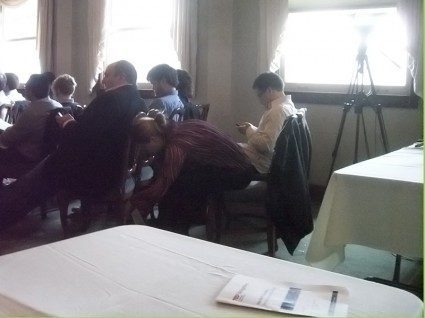I had a thoroughly enjoyable time at last Saturday’s TEDx Michigan Ave event. There was a wide variety of talks and an equally wide assortment of those in attendance. It’s always fascinating to cross pollinate with other sectors inside the wider arts field and the focus of each talk combined with the field concentration of each speaker, produced a great event…
Although all of the presentations were engaging, I found a particular connection with segments from Seth Boustead, Gwydion Suilebhan, David Loehr, Adam Thurman, and Eric Ziegenhagen and I wanted to post a few quick observations from each of their presentations.

But first, I would be remiss if I didn’t point out that on top of the presentations was an equally engaging online discussion (kicked off by @mlaffs) going on by a dozen or so in the audience who were carrying on a twitter conversation via the #TEDxMiAv.
It was an entertaining juxtaposition to experience presentations about audience engagement from several presenters only to see a number of those in attendance deeply engaged in a complementary discussion via #TEDxMiAv. At first glance, it looked like a bunch of people who weren’t paying attention but in reality, they were hyper focused on multitasking their listening/watching skills alongside their remote engagement activity (which is a five dollar phrase for tweeting).
Seth Boustead
It was particularly refreshing to hear Seth’s journey with Accessible Contemporary Music and its period of expansion following the economic downturn. It made me recall Rocco Landesman’s unfounded universal declaration from February, 2011 about too many new arts groups: “There are too many theaters,” [Landesman] said. “Look,” he explained. “You can either increase demand or decrease supply. Demand is not going to increase. So it is time to think about decreasing supply.”
Seth adequately demonstrated that creating demand, or perhaps it is better to say identifying and converting untapped demand, is something the arts can do just as well as other sectors.
Gwydion Suilebhan
The particular component of Gwydion’s talk that jumped out at me is the need for arts groups to make concerted efforts to break down the barriers between the institution and audience, especially in the area of making sense of the social media mishmash. Taking the time to monitor and respond to the online chatter is a seemingly small but crucial step toward demonstrating a sincere interest in community interaction.
I especially enjoyed the following comment: “We’re living at a time where the public is looking to trust institutions but they want to connect with ones that help them express themselves.”
David Loehr
Toward the end of David’s talk, he emphasized the need for arts groups to “never be dark,” which is a reference to using your venue space as much as possible. He provided some specific examples behind the dynamic positive benefits of this, regardless of potential strain, and it was a fascinating counterpoint to the “too much product” argument we hear far too often throughout the orchestra field.
Adam Thurman
A great discussion about the differences between hard power and soft power as it related to how arts orgs deliver their messages. There was a great bit about how hard power is comprised of how the arts have no trouble coming up with reasons why it matters so long as the public is just willing to accept us. But moving to a soft power approach, bending people toward our positions by attraction over force, is a direction the field needs to explore.
Eric Ziegenhagen
Eric made a point that connected with Gwydion from earlier in the day that arts orgs seem to have a sense that they aren’t obligated to respond to social media but that needs to change. He concluded by tossing out an idea I wish he took more time to explore which is adopting a membership model over subscriptions in such a way that transitions away from the donor ATM model.
 Special thanks goes out to the event organizer David Zoltan, he had a wonderful vision for what TEDx Michigan Ave should accomplish and I hope it is just the first step toward additional events. Likewise, special thanks to Evelyn Way, from Pindrop Acoustics, who was in charge of making sure all of the presentation slides were working. For whatever reason, I completely forgot to take the projector remote from her at the beginning of my talk and didn’t realize it until moment before the first planned slide change but she was on the ball and ready for a discreet glance to catch each transition. It came off looking like it was perfectly rehearsed.
Special thanks goes out to the event organizer David Zoltan, he had a wonderful vision for what TEDx Michigan Ave should accomplish and I hope it is just the first step toward additional events. Likewise, special thanks to Evelyn Way, from Pindrop Acoustics, who was in charge of making sure all of the presentation slides were working. For whatever reason, I completely forgot to take the projector remote from her at the beginning of my talk and didn’t realize it until moment before the first planned slide change but she was on the ball and ready for a discreet glance to catch each transition. It came off looking like it was perfectly rehearsed.
It was wonderful to see some regular Adaptistration friends at the event including Eric Stassen and Lee Streby, the latter of which filled in on live blogging duties while I was giving my talk. Speaking of the live blogging, you can read a full transcript below. I’ll post info about videos once it is available.
Sorry, the live blogging service is no longer available and does archive entries.


Thanks for the great coverage, Drew.
The common thread in all of the presentations that you encapsulate as well as your own presentation is “two-way communication.” Consider Seth’s vision of decentralized music schools world-wide and how this permits aspiring talent on the local level to communicate directly with sources of musicial opportunity. Or what about Gwydion’s brilliant analysis of the three major constituencies of a theatre, and the current absence of effective two-way communication among them; imagine what would happen if Gwydion’s vision were implemented!
You mention David Loehr and his ideas, so many it makes my head swim. Just to mention two of is thoughts, he talks about inviting audiences to “tell their own stories” and he emphasizes making your theatre a “social hub.” It would be hard to imagine two stronger examples of two-way communications.
Your own presentation on orchestra labor relations had strong overtones of two-way communications that ranged from increasing mutual respect (impossible without communications) to better training for labor representation. This last point has the important result of improving communications between the representative and the body of orchestra musicians as well as between the orchestra musicians and orchestra administration. In other words, the musicians’ representative is pivotal in the communictions process.
Adam Thurman (what a great platform artist and showman he is!) talked about “soft power,” implying our ability to sway our target populations by (what else?) encouraging attitude shifts by attraction, a more subtle form of two-way communiation.
Finally, Eric Ziegenhagen makes a compelling case for two-way communictions in many ways: he talks about how restaurants (one of performing arts’ biggest competitors) permits conversation before and after “the show (meal);” he asks if there is a social element to a performing arts venue; does the organization offer more than just the pre-show lecture (one-way) or the post-performance talk-back; and he suggests that “memberships” are more powerful than “subscriptions.” This last point is intriguing. Membership implies (to me, anyway) strong possibilities for two-way communcation while a subscription has less appeal in this regard.
This common thread of two-way communication is hardly a new concept. For-profit and nonprofit marketers have seen this shift coming for a number of years and depending on the marketing program, have implemented it with varying degrees of success. Overall, it seems to me that nonprofit marketers, especially performing arts nonprofit marketers, are well behind the pack in this regard and need to run pretty fast to catch up to the rest of the organiztions (both for-profit and nonprofit) that compete for the target audience’s attention.
TEDx Michigan Avenue gave me a number of really good ideas in this regard. I hope others benefitted as much as I did.
Thanks again for all your hard work!
Best,
Milan
And thanks for taking the time to post your feedack Milan, it’s always useful to see the same thing from multiple perspectives!
Fantastic observations. I loved that Gwydion quote as well especially. Thank you again for being a part of an amazing experience, Drew!
And thank you for bringing it all to life.
Just stumbled on this, and read the Twitter feed. In response to your question: “Drew McManus:
I want to know what Walters defines as a business plan that is sustainable?,” I mean a business plan that only minimally relies on subsidy. As far as your concern that the culture may be shifting and people may be preferring the chain to local food — I think the opposite it true. The local food and the slow food movement, for instance, and homesteading is leading people to see local agriculture as preferable and sustainable. Unfortunately, in the theatre we don’t have a real movement toward the local. However, companies like the Rude Mechanicals in Austin are good examples of people who create work from the ground up that reflects a local sensibility.
Thanks for the reply Scott although enough time has passed I don’t recall exactly what I was thinking at that time when I came up with the question, but it’s always good to have the added info!